
Puget Sound’s only native oysters were nearly wiped out in the 19th century from overharvesting. Now a network of scientists and advocates is working to restore them to their historical and cultural prominence.

Shallow waters lap at the edge of Fidalgo Bay below an old railroad trestle outside Anacortes. The shores are tangled with invasive blackberry vines and an equally prickly rain blows sideways on this cold, winter day. A solitary gull bobs at the surface of the water, and to complete the picture, clouds of white steam rise from the smokestacks of the Shell petroleum refinery in the distance.
But below the tide line here lies treasure: Millions of silver-dollar-sized Olympia oysters (Ostrea lurida). The un-showy, relatively little-known creatures live in rich jumbles that have potential to improve water quality, feed young salmon, and maybe even hedge against climate change.
A species of concern
The Olympia is the only oyster native to the West Coast of North America. But the oyster most often seen around Puget Sound is a different species: The Pacific oyster (Crassostrea gigas), introduced for aquaculture in 1902.
Pacific oysters are large and fast-growing, with a robust appearance and a purple-white shell. Olympias – known affectionately as Olys – are smaller, rounder, and more delicate looking overall. They also generally live lower in the intertidal than Pacifics, making them less visible to the casual observer.
Prior to European settlement, dense assemblages of Olympia oysters covered as many as 20,000 acres, or 26.7% of Puget Sound’s intertidal zone, according to the Washington Department of Fish and Wildlife. Today they occupy about 5% of their original range, prompting a slew of state and federally-funded restoration efforts focusing on places like Fidalgo Bay.
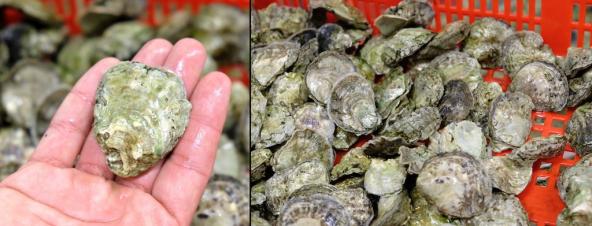
Fidalgo Bay is one of the state’s 19 priority sites for Olys in Puget Sound, and by the measure of biologists, a success story. Dense oyster beds now cover more than two-and-a-half acres of tideland on the eastern side the bay.
“It's the first time in Puget Sound that an area that's been empty of Olympia oysters has repopulated like this,” says Paul Dinnel, a retired Western Washington University shellfish biologist and member of the Skagit County Marine Resources Committee which has been coordinating restoration efforts here since they began in 2002.
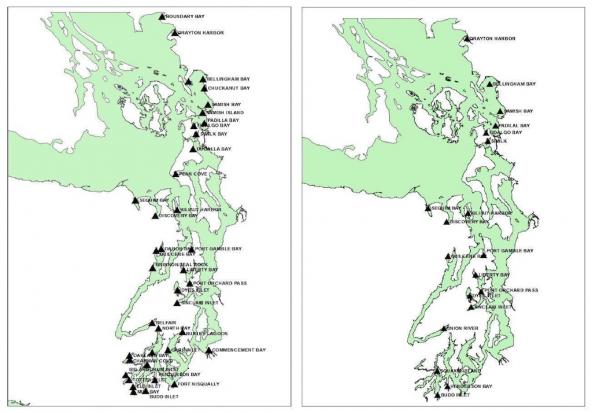
The 19 Olympia oyster priority sites, which range from Budd Inlet near Olympia to Drayton Harbor just south of the Canadian border, are pieces of two larger puzzles.
First, restoring shellfish beds of all kinds is a major priority for improving the health of Puget Sound. Second, a network of scientists and advocates is working to restore Olympia oyster populations throughout the species’ historic range, which stretches from southeastern Alaska to Baja California.
Pieces of gold
To bring the oysters back to Puget Sound, biologists first had to identify where they once were. Marco Hatch, assistant professor of environmental science at Western Washington University, combed through early ethnographic reports, explorers’ diaries, and archaeological literature on shell middens to identify 21 locations in northern Puget Sound alone where substantial populations of Olympia oysters once existed. These do not necessarily represent all historic Olympia oyster populations, Hatch says, but many of them correspond to current priority restoration sites.
The importance of oysters to Native tribes exists not only in shell middens but in names. The Samish names for a number of small islands in the tribe’s traditional territories in northern Puget Sound reference food resources historically found there, according to Samish language program manager George Adams. Patos Island is known as Tl’xwóyten, meaning “place where you get oysters,” says Adams, an enrolled member of the Nooksack tribe who also has Lummi and other Indigenous heritage. (The Samish word for oyster is Tl’éxwtl’éxw. Samish includes sounds that do not exist in English. Tl’ indicates a clicking sound made towards the back of the mouth, says Kelly Hall, language specialist with the Samish Indian Nation and a Samish tribal member. Xw is a guttural sound made in the back of the throat with the lips rounded.)
The popularity of Olys quickly spread outside of the native tribes with the arrival of European settlers. Beginning in the 1850s, settlers harvested huge quantities of Olympia oysters from beds throughout Puget Sound. Many of the oysters were shipped to California and wound up in Hangtown Fry, a bacon-and-oyster omelet popular with gold miners feeling flush.
Rosie Cayou-James, a member of the Samish Indian Nation and cultural outreach manager for the tribe, says her grandfather remembered gathering oysters around the 1890s at what is now the restoration site near the railroad trestle in Fidalgo Bay. The area was so productive that not long after, settlers took over the site and established an oyster farm, Cayou-James says.
Throughout Puget Sound, oyster aquaculture initially focused on Olympia oysters. But as natural populations declined, growers had difficulty getting young oysters to recruit to their aquaculture beds. That spurred the introduction of the Pacific oyster, which now supports a multimillion-dollar industry in Puget Sound.
As the 20th century progressed, pollution from pulp mills, excess nutrients in runoff, and increased sediment due to logging and urban development further knocked back Olympia oysters.
But they didn’t disappear entirely. “They're like an Indian-head penny, every now and then you'd find one,” Cayou-James says. Twentieth century native shellfish gatherers never harvested such oysters, she says, because they were too rare. “It was a piece of gold.”
Today, with less than 5% of historic Olympia oyster beds remaining, what’s gone is not the species but the habitat form. And it’s that habitat form that restoration advocates are working to bring back.
Seeds of recovery
One morning in December, roughly 1,500 Olympia oysters rest in red plastic baskets stacked in an open tank at the Kenneth K. Chew Center for Shellfish Research and Restoration. The facility, jointly operated by the National Oceanic and Atmospheric Administration (NOAA) and the nonprofit Puget Sound Restoration Fund (PSRF), produces oyster seed for restoration projects throughout Puget Sound – an average of two million young Olympia oysters every year.
The broodstock oysters in the tank were collected from Fidalgo Bay during a recent nighttime low tide. The animals are subtly pretty, with a yellow-greenish cast like a watery verdigris. Their shells are open ever so slightly, a sign that they’re filter-feeding after hatchery staff added an algae “smoothie” to the water a few hours ago.
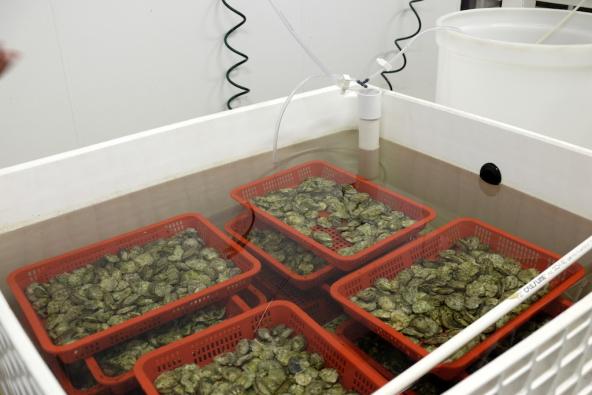
“Basically right now we're trying to convince them that it's time to spawn,” says Ryan Crim, PSRF’s hatchery manager.
In the wild, Puget Sound Olympia oysters begin spawning in May or June. “We trick them by just warming the [water] temperature up and giving them lots of food” to mimic the spring algal blooms, Crim says. “And that works really well for these guys.”
Any day now, the male oysters will begin to release sperm into the water of the tank. The females will release ripe eggs into their mantle cavity to be fertilized, then brood their larvae for about two weeks.
Later, when the female oysters begin releasing the microscopic larvae into the water, Crim and his team will attach a fine-mesh screen to the tank’s outflow valve to catch them. They’ll transfer the larvae to rearing tanks in the next room to feast on phytoplankton under precisely controlled environmental conditions.
Three to four weeks later, the larvae will be about a quarter-millimeter in size, making the water of the rearing tanks look as if it were full of black pepper flakes, and ready metamorphose, or “set.” The team will move them to setting tanks outside the hatchery building: Seven covered, above-ground pools wrapped in silver insulation, like oyster hot tubs.
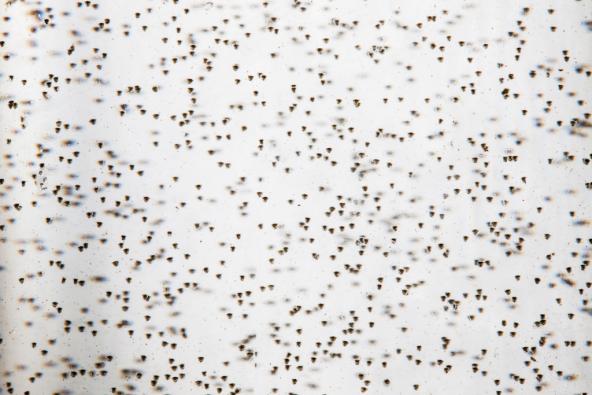
The setting tanks contain plastic mesh bags of cultch – Pacific oyster shells for the spat, or young Olympias, to settle on. Then it’s more phytoplankton feasting and more growing until April, when the hatchery team loads the cultch bags into trucks and drives them to this year’s restoration sites.
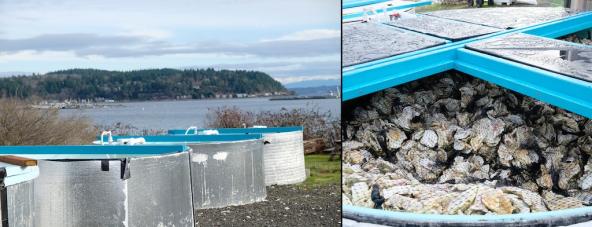
Puget Sound has four or five genetically distinct populations of Olympia oysters, corresponding roughly to the different basins that make up the sound. “We're trying to maintain the genetic diversity that exists,” Crim says, as well as any adaptations oysters may have to local conditions. Most of the oysters produced from Fidalgo Bay broodstock this year are destined for restoration projects in Drayton Harbor and Barlow Bay on Lopez Island.
Making their bed
Why go to all this trouble? Simply put, a dense bed of Olympia oysters has vital ecological roles that the scattered individual oysters now found on Puget Sound shorelines can’t carry out. “Restoring Olys is a way to restore one of the foundational components of a healthy ecosystem,” says PSRF executive director Betsy Peabody, who has been working on Olympia oyster restoration since 1999.
Each oyster filters up to two gallons of water a day. When a bed numbers in the millions, that adds up to a lot of power to remove excess nutrients and keep algal blooms in check. “Having large, healthy oyster populations helps filter the waters and keep our waterways clear and clean,” says Hatch.
In addition, Olympia oyster beds organize the soft-bottom habitat that characterizes much of the lower intertidal in Puget Sound. “In the absence of oysters, you have sort of gooshy mud,” says Bonnie Becker, who studies Olympia oysters and other bivalves at the University of Washington in Tacoma. “And so the oysters form a stable structure for other organisms to live on.”
Those other organisms include tiny creatures like copepods, isopods, and amphipods – epibenthic invertebrates that make their living in the nooks and crannies between the oyster shells. Brian Allen, head of PSRF’s Olympia oyster program, likens an oyster bed to “a factory for epibenthic invertebrate production.”
In turn, those invertebrates are food for small fish, including juvenile salmon. Researchers have documented higher densities of favorite salmon prey items in restored oyster beds compared to nearby unrestored habitat.
PSRF is working with other nonprofits, federal and state agencies, commercial shellfish growers, and at least 9 Native tribes to restore 100 acres of Olympia oyster beds in Puget Sound by 2020.
“It was a reach goal,” says Peabody. “But it seemed doable.”
So far, PSRF has implemented Olympia oyster restoration on 67 acres of tideland. Projects range in size from 10 acres each in Port Gamble Bay and Liberty Bay and nine acres in Dogfish Bay, to an acre and a half in Sequim Bay and various beds of about an acre or less in Squaxin Island, Skagit Bay, and Similk Bay.
Projects planned for the next two years should come within striking distance of the 100-acre goal, Peabody says, including 15 acres in Sinclair Inlet and five acres in Dyes Inlet, depending on funding.
A site is considered to have achieved a self-sustaining, structured assemblage of oysters when it contains at least 75 Olympia oysters per square meter. That benchmark is based on a survey of Puget Sound’s largest remaining natural Olympia oyster bed, a 60-acre site in North Bay.
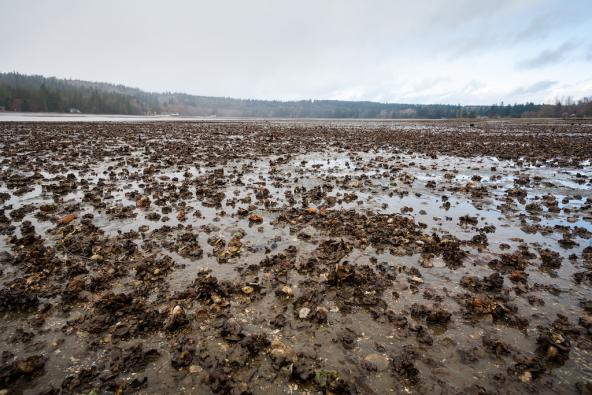
But that may not even fully capture what Olympia oysters are capable of. In 2013, a census of oysters in Dogfish Bay yielded an estimate of 85 oysters per square meter. Four years later, that same site contained 163 oysters per square meter.
PSRF began pilot projects in Dogfish Bay in 2000, and major restoration efforts in 2007, so this didn’t happen overnight, Peabody says. “But, you know, you start to rebuild that engine and then it kicks in.”
Future feast?
That’s not to say there haven’t been challenges. Funding is always limited, of course, and getting access to the most promising sites for restoration can be difficult since much of the tideland in Puget Sound is privately owned.
Then there is the massive uncertainty associated with climate change and ocean acidification. Some people see Olympia oysters themselves as a potential bulwark against climate change. “We're looking for ways to help the tribe be more resilient in the face of climate change,” says Julie Barber, a shellfish biologist working for the Swinomish tribe. “I think the best way to start looking at a resilient ecosystem is to work with endemic species and not non-natives.”
But exactly how the oysters will fare in future ocean conditions is uncertain. Some evidence indicates that Olympia oyster larvae are less vulnerable to ocean acidification than Pacific oysters during their initial period of shell formation. But other studies suggest that exposure to acidification stress during the larval stage could cause oysters to fare poorly later in life.
Moreover, rising water temperatures could deliver a double-whammy to Olympia oysters by impairing their ability to reproduce and increasing competition from more warm-adapted Pacific oysters, says Mike Behrens, a biologist at Pacific Lutheran University in Tacoma.
“I think the biggest challenge at this point is probably how these environmental changes are going to interact with current restoration efforts,” Behrens says.
Officially, the goal of Olympia oyster restoration is to increase intertidal habitat by rebuilding oyster beds. But beyond this, could Olympia oysters once again become a wild-harvested food as they were for thousands of years?
It will likely be decades before restored oyster beds could sustainably support even a limited subsistence harvest, restoration advocates say. But to some Native people, that aspiration is a resonant one.
About five years ago, the Samish tribe hosted a shellfish feast as part of a Canoe Journey, an annual event that brings together Native tribes from around the Salish Sea. They steamed clams, mussels, and other shellfish in a traditional pit dug in the sand on the beach. Young people delivered plates of food to the elders. And the oysters served that day? Pacifics purchased from a commercial grower.
“We’re not there yet,” says Hatch, who is also a Samish tribal citizen. “But nonetheless, it would be great if we could help bring back that piece of our Indigenous food system.”









